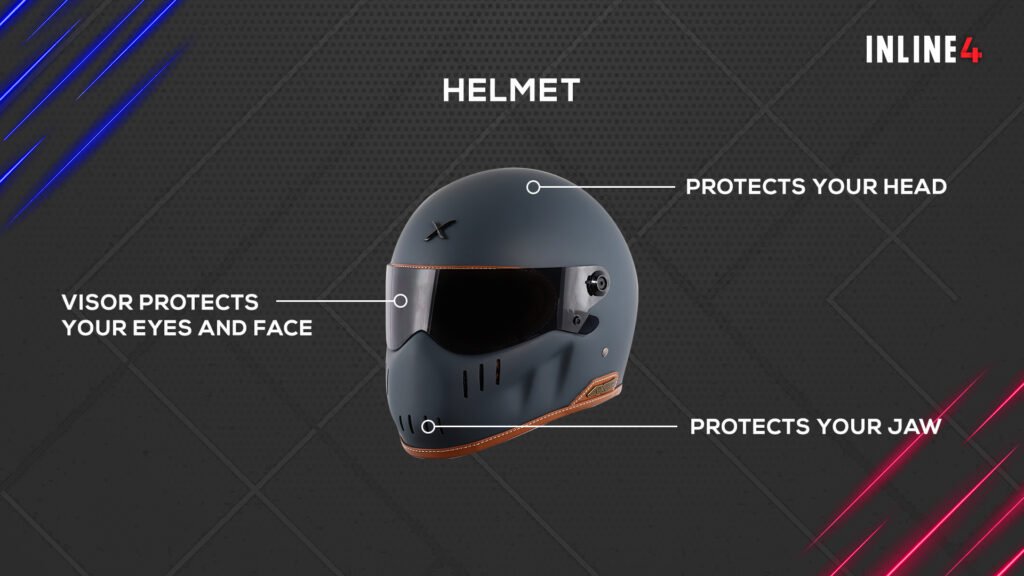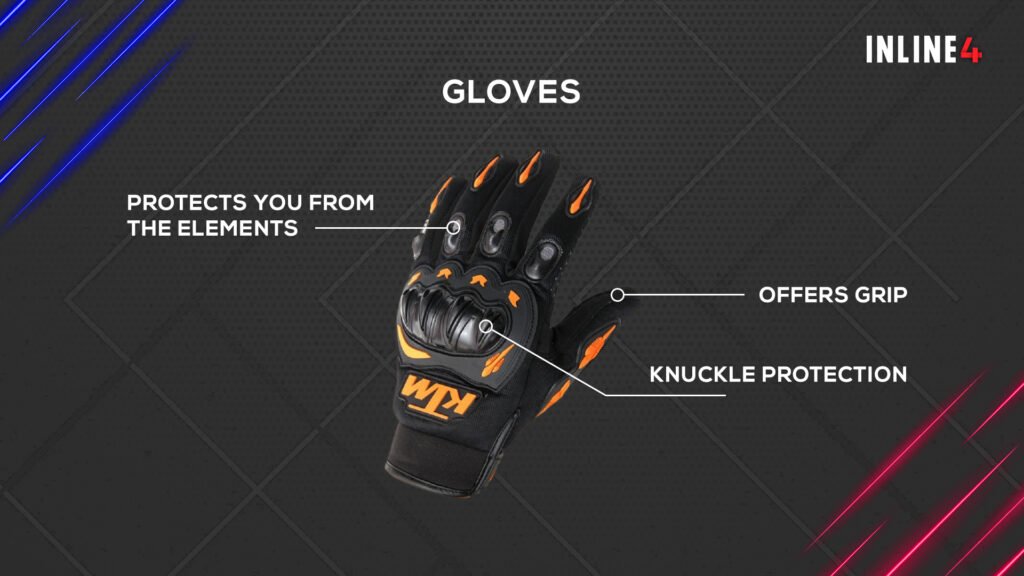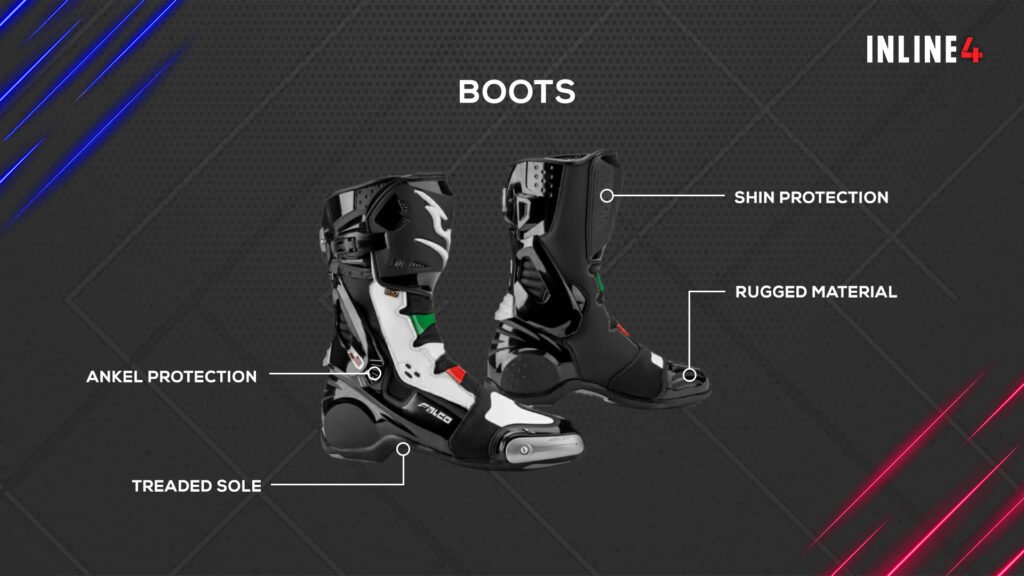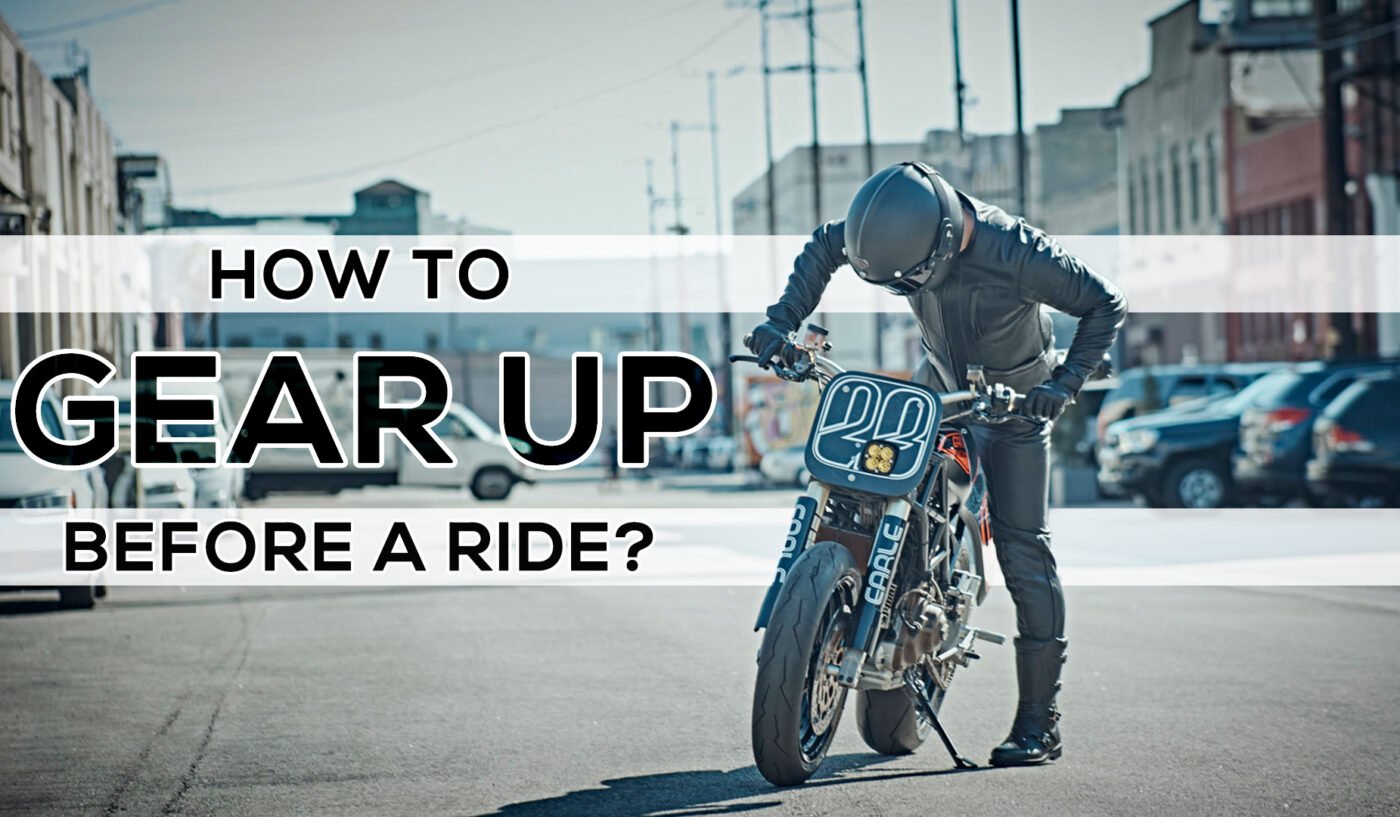Yeah, we know, you’re a daredevil and you don’t need a helmet or any of those biking gear stuff for your ride. It’s not cool to wear them and you wouldn’t want to mess your hair up or crease your t-shirts. Even if you did use them, it would be just a helmet and just because you can see the cops in the corner.
Although within city limits, the complete biking gear is not needed. However, it doesn’t hurt to protect yourself. And trust me. You with the complete gear would look cool. Intimidating even. People see you flexing that full biking gear suit and they’re probably gonna think twice before cutting you off. Also, unlike cars, motorcycles do not provide structural protection.
Now to most people out there, helmets are the only thing that comes to mind while talking about safety during riding. But there’s a lot more than helmets, to protect you in case of an accident. You can have gloves, jackets, boots, an entire riding suit even. Each of these has its specific function and wearing them together goes a long way in keeping your body intact. While most of us know about these, we’re not sure why and how to use them. If you’re one of ’em, well then, you should continue reading this.
Helmets

How helmets protect you:
- Reduces the risk of head injuries: In case of an impact, the chances of injuring your head are very high. And with your head being one of the most important parts of your body, it’s really important to protect it. Even a minor impact on your head can cause severe damage. And then you’re forced to write a to-do list on your thigh as you’re dealing with memory loss.
- Protects you from cold wind and blistering sun: Riding at high speeds also brings its own set of difficulties, one being wind. And if it’s especially winter then high-speed cold winds are not very pleasant. Wearing a helmet, however, protects you from the elements. Even during extreme summer, wearing a helmet makes sure you don’t get tanned.
- Protects your eyes: High-speed winds, especially those carrying dust and insects what not can be annoying. And if it makes contact with your eyes, it can hurt. However, having your visors protects your eyes from such scenarios.
- It’s easy on your wallet: With cops on the prowl more than before, wearing a helmet goes a long way in avoiding unnecessary stops. The chance of you getting stopped while wearing a helmet is quite less. This way you can avoid getting caught and risk blowing your cover of being an international sleeper cell handler.
How to choose the right helmet:
- Figure out the right helmet type for you: There are open-faced, half helmets, and full-faced helmets. Out of these, only the full-faced ones provide complete protection, so buying that is a better option.
- Check the fit: Once you have decided on which type you want, wear the helmet and see how it fits you. Most new helmets are initially a bit tight and need to be broken in. Wear the new helmet for about 30mins. And if you feel any sort of discomfort, like squeezing your forehead or if it leaves a mark on your face, you should try a bigger one. Helmets should have a snug fit, enough to squeeze your cheeks a bit to make you look like a chipmunk, but not cause any kind of pain.
- Choose the type of visor you want: There are three kinds of visors, Clear, dark, and Iridium visor. Opt for a clear visor if you also travel during the night. Dark helmets offer you protection from sunlight however they are not much useful at night. Iridium is the one where it has a reflective screen on the outside and people can’t see what’s inside the helmet. Perfect for stalking your crush.
- Choose a helmet with a good inner lining: A helmet with an inner cushion or lining goes a long way in keeping you comfortable, especially on long rides. Choose helmets with removable lining, which you can wash every couple of months.
While there are those fancy helmets with ridiculous prices you can always go for a more simple one and customise it, with stickers from Inline-4.
Gloves
And before you ask any questions, by gloves I mean the proper riding gloves with cushions for your knuckles. These do not include the maroon-colored mittens your granny stitched up for you. And it does not mean your half, fingerless gym gloves, no matter how hard you try you won’t look like a UFC fighter, calm down.

Why gloves?
- Protects your hands during impact: Gloves with inner linings can protect your hands in case of impact. This prevents scraping of your skins and thus you won’t have to take your mom’s help to feed yourself. Sometimes they might even protect your wrists and your finger bones to an extent.
- Protects your hands from the elements: Riding at high speed, especially during the winter, your hands tend to freeze up, which makes riding even more difficult. Oftentimes you have to resort to keeping your hands over the silencer to warm them. Even during the extreme sun, your hands tend to get tanned and look like you just used your hands to dig up a grave. Wearing gloves can prevent such scenarios from ever happening.
- Gives you a better grip: During long rides, especially during the winter, your palms might get sweaty. If you’re one of those who sweat a lot, this can be a huge hindrance. Sweat reduced your grip and this makes riding difficult. Gloves however with their patterned groove and lining offer you a good grip on the handle.
- Reduced wear on the bike handle: Constant exposure to sweat and moisture might put a lot of wear on the bike handles. Wearing gloves however makes sure that your grip stays intact for a longer period.
Choosing the right gloves:
- Pick the right kind of gloves: There are different types of gloves. These depend on what kind of bike you drive and where and in what climate are you going to be driving. For sports bikes, thinner gloves with pre-curved fingers give you better control. For city limits on a medium-powered bike, short gloves are better, which are usually a combination of leather and textile. However, if you’re planning on a long journey, full gauntlet gloves are recommended. These protect your hands and arms from the elements. Also make sure your gloves matches the rest of your biking gear.
- Check for a snug fit: Gloves should neither be tight nor be loose. New gloves take time to break in. When choosing new gloves, go for the ones which are tight but comfortable and with proper fastening straps.
- Material of the gloves: You can either go for synthetic, leather, or even textile-based gloves depending on your preference. Leather gloves are suitable for quicker bikes and fast maneuvering. Textile gloves are bulkier and are preferable for long journeys and offroading.
- Other features: Some gloves offer a wide variety of features, this includes, a visor wiper to clear your visor. Touch screen compatibility, so that you can easily operate your devices without removing the gloves.
Jackets
I know what you’re thinking, Jackets? Especially ones just for riding? I can easily use my normal pullover, can’t I?
Well short answer, no, here’s why.

- Jackets provide you with protection: Unlike your pullover, which you got for your graduation 4 years ago, motorcycle jackets come with padding in the elbows, shoulders which protect those sensitive spots during an impact. They can also prevent scraping of your skin and protect you from burns in case of a fire-related incident. Most jackets are waterproof so you don’t have to worry about the rain.
- Jackets are comfortable: During long rides, especially at high speeds, normal jackets tend to wave around a lot with the wind. This is not only annoying but distracting too. Motorcycle jackets, however, don’t flap around and are perfectly streamlined for high speeds.
- Protects you from the elements: Be it the harsh winter, rain, or even the sun, jackets are designed to protect you from them. They are also waterproof. So if you’ve got the complete biking gear setup, you don’t have to worry about getting wet.
- Jackets look cool: Jackets nowadays are not only designed for comfort and function but style too. So you’re sure to catch some attention when your rock them. Just like our keytags.
Choosing the right jacket:
- Choosing the right material: Mesh jackets include a mesh on the front and back supported by textile material, these are lightweight, offer good ventilation, and do not tear off when scraped against hard surfaces. Then there are textile jackets, which are usually opted to protect yourself from dust and small abrasions. However, these aren’t waterproof and are not suitable for Indian weather.
Then there are leather jackets, which can get quite hot during summer, but offer excellent abrasion protection and last for a long time.
- Type of jacket: The two major kinds of jackets are the sporting and touring ones. Sporting ones are tighter fitting and are streamlined to provide better aerodynamic quality. Touring jackets are usually loose-fitting, have a lot of pockets for you to carry mid-journey snacks in case you get hungry even after than seven-course meal. They are aimed at protecting you from the elements that provide an aerodynamic function, they are suitable for long rides.
- Choose jackets with high visibility: While black jackets are cool, make sure they have reflective material on them. These can be helpful, especially on roads with limited lighting, and can prevent accidents.
- Jackets with proper padding and venting: Wearing a jacket can get quite annoying, especially during summer. So make sure it has vents to provide air circulation and also proper lining on the shoulders and elbows to protect your bones during an accident.
Pants
While jeans do offer good protection from the weather, they’re quite useless like your college degree, in case of falls and can easily tear and cause abrasion on your skin. Also, you wouldn’t want to tear your favorite pair of jeans you’ve been rocking for 5 years now, would you?

Other reasons why you should consider riding pants:
- Impact protection: Pants can be worn over your normal pants, so you don’t have to worry about changing in your dirty office washroom. These pants usually come with sliders that protect your knees during accidents.
- Waterproof: Riding pants are usually waterproof, so you can easily go out riding during the rain, however, we do not recommend this. So don’t go suing us if and when you skid because you wanted to drive in the rain.
I repeat, Inline-4 does not recommend driving in the rain. What we do recommend is having the whole biking gear setup.
Choosing the right pants:
- Go for a larger size than usual: While buying riding pants opt for one size larger, this will make it easier to wear them over your normal pants and will also be comfortable during riding and you won’t have to stretch your groin and risk a groin injury. Tight pants can also give you a wedgie and that can always be uncomfortable and traumatizing if you’ve had a rough school life.
- Choose pants with knee sliders: Knee sliders offer protection to your knees in case you decide to jump off your bike before you drive it off a cliff GTA style. So make sure the pants have them before buying them.
Boots
Now, this can cause a lot of debate, while some of you might want to show off their new Air Jordans, others might wonder, after all, they’re just boots, basically the same as my shoes. While it is true in most cases, boots offer more protection than you think. And well, boots with the rest of the biking gear does look pretty slick.

- Boots offer protection to your ankles: While most shoes might protect your feet, they offer little or no protection to your ankles. And the risk of injuring your ankles in an accident is very high. Riding boots prevent your ankle from twisting too in case you land on them or if your bike falls on your legs.
- Your normal shoes can still stay clean: Riding a motorcycle, especially in India can be a dirty affair. However, it won’t matter if you’ve got boots on, most of them are waterproof and can easily be cleaned. This infact can work for the entire outfit if you go for the entire biking gear setup.
- Easier to ride: Boots make it easier to shift gears and they also offer your grip when you put your leg down on a slippery surface.
Choosing the right boots:
- Choosing the right size: Make sure your boots fit you properly because if they don’t, it can be very distracting while riding. Your riding shoes should be as comfortable as your normal shoes.
- Should be made from a rugged material: Your boots should be able to withstand extreme heat, in case of contact with the silencer. It should also be resilient towards any sort of chemicals and oils.
- Boots with a flat and treaded sole: Make sure your boots have a flat sole instead of heels and should have good treading to give you proper grip while riding.
Now while wearing all these aren’t mandatory in India, excluding the helmet. However seeing how people drive around here, it’s a good choice to invest in these gears to better protect yourself. Also, over the past decade, there’s been a gradual shift of priorities when we consider motorcycles. Nowadays motorcycles are not just a means of travel. A large section of the population considers motorcycles as something they can use to have fun with. With so many different kinds of bikes
And if you’re considering going on a ride, then a biking gear is necessary. Because life is uncertain and it’s always wise to stay prepared in case you’re caught in a high-speed chase with the authorities.



Pingback:Tips for Preparing a Long Motorcycle Tour